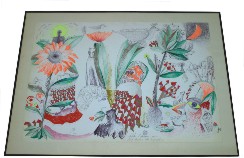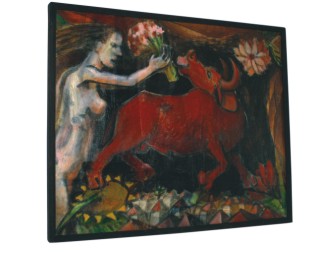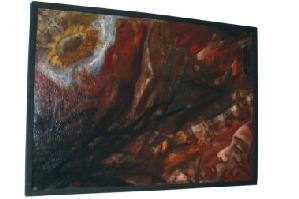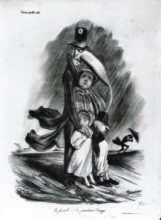 Talking wolves and troublesome cats mix with pornography and abstract lunacy, as Michael Bird reviews Mircea Nechita's images of fairy tales with a twist
Talking wolves and troublesome cats mix with pornography and abstract lunacy, as Michael Bird reviews Mircea Nechita's images of fairy tales with a twist
Through the dirt track of the village, pigs snuffle for roots, cats knock over a dustbin, an old drunk shouts at passers-by, a man is chased by a barking fox, sunflowers lean over the street with the inquisitiveness of a nosey neighbour, while in the trees around the small-roofed houses, wolves watch for scraps of food and small creatures to terrorise.
But into this pastoral scene arrive images of a man lying down among the hills, forming part of the land, as vegetation sprouts forth from his body.
People fall asleep in the hammock of a flower's stamen, piles of bodies writhe in sexual ecstasy and a giant fountain pen attacks and bleeds the landscape.
 42 year-old Mircea Nechita, in this small exhibition of pen and ink, lithograph and oils, shows scenes from his life in rural Maramures, but allows surreal and abstract intrusions to upset their linear and proportional logic, creating a hallucination that veers from the disturbing to the lyrical to the ridiculous.
42 year-old Mircea Nechita, in this small exhibition of pen and ink, lithograph and oils, shows scenes from his life in rural Maramures, but allows surreal and abstract intrusions to upset their linear and proportional logic, creating a hallucination that veers from the disturbing to the lyrical to the ridiculous.
This, the third exhibition from the Euterpe gallery, aims to continue the establishment's aim of presenting new art in the old quartiers of Bucharest.
Using the naïve style that finds a home in children's illustrations, the influence of Chagall is most evident in the joie de vivre this exhibition, self-evidently titled 'Dreams, stories, visions'. In one oil painting 'Flowers', bulls charge over small village huts, pursued by a naked woman brandishing a bunch of flowers leading a viewer to ask, what is the story behind the picture?
But there is no linear narrative to these pictures, instead Nechita takes characteristics of fairy tales - giants, talking animals and elemental leitmotifs, such as fruit, the earth, the moon and the sun, and centrifuges them in a phantasmagoric, but often confusing experiment. Night mixes with day, contemporary society with fantasy, and fables with visions of pornographic excess
 Perhaps Nechita, a former engraver, is still trying to find the correct tools to express his visions. The oils are more vague and abstract, while the pen and ink drawings seem to find it hard to shake off their status as illustrations. But in the lithographs, Nechita shines.
Perhaps Nechita, a former engraver, is still trying to find the correct tools to express his visions. The oils are more vague and abstract, while the pen and ink drawings seem to find it hard to shake off their status as illustrations. But in the lithographs, Nechita shines.
His talents emerge completely in 'Full Moon', where the most resonant elements of the night are amplified in scale a bull in search of a mate and a howling wolf tower over the rooftops of the city, where the houses are drawn in miniature. The nocturnal peace is, however, arrested by a giant lunar object in the shape of a geometrical matrix containing trees, faces and abstract visions.
Bizarre and beautiful, sensual and enlivening, these images do occasionally lapse into sentiment and lack an original style, but do prove that exciting fine art is thriving in
Romania's provinces.
Mircea Nechita 'Vise, Povesti, Inchipuiri' is on at the Centrul si Galeria de Arta Euterpe, Str Duzilor nr 5, Until 31 March, Tel 253 25 00
To love paris or…
 A contemporary of Picasso and Matisse, Theodor Pallady is not alone among Romanian artists who headed to the French capital to hone his talents in the age of post-impressionism.
A contemporary of Picasso and Matisse, Theodor Pallady is not alone among Romanian artists who headed to the French capital to hone his talents in the age of post-impressionism.
At the National Art Musuem, the Iasi-born painter displays a small exhibition of his preliminary sketch work, mostly in pen and gouache, highlighting the strengths and weaknesses of his international renown.
Even using primitive materials in sparing amounts, he manages to capture the grey-blue and sullen Parisian sky perfectly, while also encapsulating the gentle light and faint yellow rays that shine upon inter-war Bucharest villas and the southern French countryside in the summertime.
But his attempts at portraiture are less successful. His pictures of women lend all the models thick arms, heavy-set eyebrows and masculine jaw-lines, while the self-portraits are banal. However, in this small exhibition, there is one great exception. In an oil-on-cardboard painting of his frequent muse Louise Buges, Pallady manages to capture, by showing her folded legs defensively poised against the viewer, at the same time as her hand brandishes an open fan in the same direction, an effective contrast of aggression and playfulness.
A must-see for Pallady enthusiasts, it will probably not convert anyone else to his talents as anything other than a Romanian-born artist famous for painting pictures of Paris in a slow drizzle.
… to hate Paris
Paris is a poor, sick and unlawful urban nightmare in the works of early 19th century iconoclastic French artist Daumier. The Republican satirist's drawings, also on display at the National Art Gallery through March, mercilessly attack the selfishness of the pampered gentry and the impoverished underclass, with conflict rampant at the time of Louis-Philippe.
Cuckolded husbands argue with sick wives, while in depicting a vandal with a club asking the passer-by the time, he shows how the Parisian nature veers between politeness and brutality.
Even in the most isolated of images, La journee du celibataire (A day in the life of a bachelor), the single man in the quiet of his atelier has not escaped the violence of the world outside, as he has to keep his dog, canary and cat from eating each other.
Highlighting his work as a cultural critic rather than an artist, this series, even when it touches upon matters of the heart, such as a sad old man looking regretfully on a love lost, never resorts the satirist's great enemy, sentiment.
Instead it alights upon the sine qua non of all good caricaturists, the misanthropic eye that sees all people as either evil or weak.
National Musuem of Art, Calei Victoriei 49-53,
closed on Monday and Tuesday,
open Wednesday to Sunday - 10:00 to 18:00 hrs